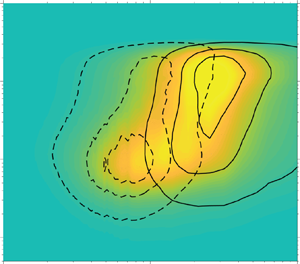Crossref Citations
This article has been cited by the following publications. This list is generated based on data provided by
Crossref.
Li, Zexiang
Liu, Xiaochao
Lv, Pengyu
and
Feng, Yi
2022.
Drag reduction of blowing-based active control in a turbulent boundary layer.
Physics of Fluids,
Vol. 34,
Issue. 11,
Ma, Rui
Gao, Zheng-hong
Lu, Lian-shan
and
Chen, Shu-sheng
2022.
Skin-friction drag reduction by local porous uniform blowing in spatially developing compressible turbulent boundary layers.
Physics of Fluids,
Vol. 34,
Issue. 12,
Varela, Pau
Suárez, Pol
Alcántara-Ávila, Francisco
Miró, Arnau
Rabault, Jean
Font, Bernat
García-Cuevas, Luis Miguel
Lehmkuhl, Oriol
and
Vinuesa, Ricardo
2022.
Deep Reinforcement Learning for Flow Control Exploits Different Physics for Increasing Reynolds Number Regimes.
Actuators,
Vol. 11,
Issue. 12,
p.
359.
Atzori, Marco
Vinuesa, Ricardo
and
Schlatter, Philipp
2022.
Control effects on coherent structures in a non-uniform adverse-pressure-gradient boundary layer.
International Journal of Heat and Fluid Flow,
Vol. 97,
Issue. ,
p.
109036.
Vaquero, Jaime
Renard, Nicolas
and
Deck, Sébastien
2022.
ZDES Simulation and Spectral Analysis of a High-Reynolds-Number Out-of-Equilibrium Turbulent Boundary Layer.
Flow, Turbulence and Combustion,
Vol. 109,
Issue. 4,
p.
1059.
Ricco, Pierre
and
Skote, Martin
2022.
Integral relations for the skin-friction coefficient of canonical flows.
Journal of Fluid Mechanics,
Vol. 943,
Issue. ,
Liu, Yixun
Liu, Chun-Ho
Brasseur, Guy P.
and
Chao, Christopher Y.H.
2023.
Empirical mode decomposition of the atmospheric flows and pollutant transport over real urban morphology.
Environmental Pollution,
Vol. 331,
Issue. ,
p.
121858.
Ji, Feng
Ding, Jing
Lu, Jianfeng
and
Wang, Weilong
2023.
Direct Numerical Simulation of Thermal Turbulent Boundary Layer Flow over Multiple V-Shaped Ribs at Different Angles.
Energies,
Vol. 16,
Issue. 9,
p.
3831.
Atzori, Marco
Mallor, Fermín
Pozuelo, Ramón
Fukagata, Koji
Vinuesa, Ricardo
and
Schlatter, Philipp
2023.
A new perspective on skin-friction contributions in adverse-pressure-gradient turbulent boundary layers.
International Journal of Heat and Fluid Flow,
Vol. 101,
Issue. ,
p.
109117.
2023.
Analysis of the aerodynamic characteristics of the entire operation process of an ultra-high-speed elevator under the influence of high blockage ratio, hoistway, and car height parameters.
Physics of Fluids,
Vol. 35,
Issue. 7,
2023.
The effect of spanwise wall oscillation on spatially developing compressible transitional boundary layers.
Physics of Fluids,
Vol. 35,
Issue. 7,
2023.
Numerical study on compressible flow around a circular cylinder in proximity to the wall.
Physics of Fluids,
Vol. 35,
Issue. 6,
LI, Zhiping
HE, Long
ZHOU, Jingsai
ZUO, Yueren
YIN, Yao
ZHANG, Peng
and
MENG, Bo
2024.
Numerical study on influence of protrusion heights on Reynolds stress and viscous stress variations in turbulent vortical structures.
Chinese Journal of Aeronautics,
Vol. 37,
Issue. 9,
p.
59.
Zhao, Yunchao
Fan, Yitong
and
Li, Weipeng
2024.
Reynolds number effects on a velocity–vorticity correlation-based skin-friction drag decomposition in incompressible turbulent channel flows.
Journal of Fluid Mechanics,
Vol. 979,
Issue. ,
Guo, Tongbiao
Tong, Fulin
Ji, Xiangxin
and
Li, Xinliang
2024.
Direct numerical simulations of supersonic flat-plate turbulent boundary layers with uniform blowing.
Physics of Fluids,
Vol. 36,
Issue. 4,
Zhang, Qiao
and
Zhang, Weiwei
2024.
A hybrid approach for reconstruction of transonic buffet aerodynamic noise: Integrating random forest and compressive sensing algorithm.
Aerospace Science and Technology,
Vol. 152,
Issue. ,
p.
109379.
Zhuang, Guo-Hui
Wan, Zhen-Hua
Liu, Nan-Sheng
Sun, De-Jun
and
Lu, Xi-Yun
2024.
Instability and transition control by steady local blowing/suction in a hypersonic boundary layer.
Journal of Fluid Mechanics,
Vol. 990,
Issue. ,
Shi, Xiaotian
Liu, Wanhai
Ji, Xiangxin
Sun, Xuecheng
Liu, Hongwei
Li, Xinliang
and
Yu, Changping
2025.
Effect of curvature on the hypersonic turbulent boundary over the curved compression ramp.
Physics of Fluids,
Vol. 37,
Issue. 1,
Li, Wenhui
Gu, Yifan
Zhao, Weifeng
Deng, Yelin
and
Fan, Xueliang
2025.
Alleviating tunnel aerodynamics through hybrid suction & blowing techniques applied to train nose sections.
Journal of Wind Engineering and Industrial Aerodynamics,
Vol. 256,
Issue. ,
p.
105961.

 $Re_c=200\,000$ and
$Re_c=200\,000$ and  $400\,000$. The connection of the drag reduction/increase by using blowing/suction with the turbulence statistics (including viscous dissipation, turbulence kinetic energy production and spatial growth of the flow) across the boundary layer, subjected to adverse or favourable pressure gradients, is examined. We found that the inner and outer peaks of the contributions associated with the friction-drag generation show good scaling with either inner or outer units, respectively. They are also independent of the Reynolds number, control scheme and intensity of the blowing/suction. The small- and large-scale structures are separated with an adaptive scale-decomposition method, namely the empirical mode decomposition (EMD), which aims to analyse the scale-specific contribution of turbulent motions to friction-drag generation. Results unveil that blowing on the suction side of the airfoil is able to enhance the contribution of large-scale motions and to suppress that of small scales; however, suction behaves contrarily. The contributions related to cross-scale interactions remain almost unchanged with different control strategies.
$400\,000$. The connection of the drag reduction/increase by using blowing/suction with the turbulence statistics (including viscous dissipation, turbulence kinetic energy production and spatial growth of the flow) across the boundary layer, subjected to adverse or favourable pressure gradients, is examined. We found that the inner and outer peaks of the contributions associated with the friction-drag generation show good scaling with either inner or outer units, respectively. They are also independent of the Reynolds number, control scheme and intensity of the blowing/suction. The small- and large-scale structures are separated with an adaptive scale-decomposition method, namely the empirical mode decomposition (EMD), which aims to analyse the scale-specific contribution of turbulent motions to friction-drag generation. Results unveil that blowing on the suction side of the airfoil is able to enhance the contribution of large-scale motions and to suppress that of small scales; however, suction behaves contrarily. The contributions related to cross-scale interactions remain almost unchanged with different control strategies.